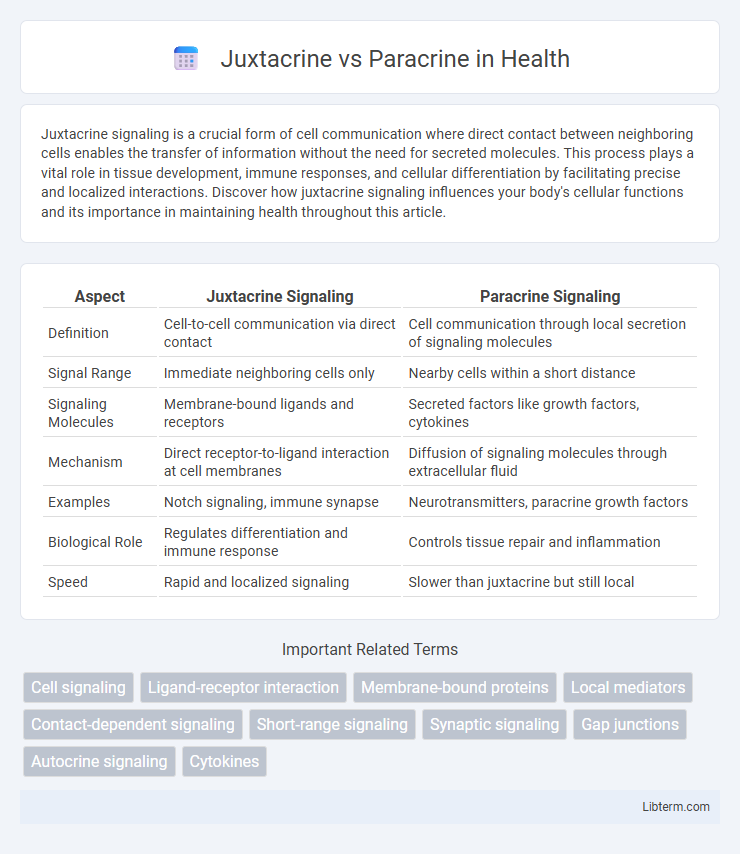Juxtacrine signaling is a crucial form of cell communication where direct contact between neighboring cells enables the transfer of information without the need for secreted molecules. This process plays a vital role in tissue development, immune responses, and cellular differentiation by facilitating precise and localized interactions. Discover how juxtacrine signaling influences your body's cellular functions and its importance in maintaining health throughout this article.
Table of Comparison
| Aspect | Juxtacrine Signaling | Paracrine Signaling |
|---|---|---|
| Definition | Cell-to-cell communication via direct contact | Cell communication through local secretion of signaling molecules |
| Signal Range | Immediate neighboring cells only | Nearby cells within a short distance |
| Signaling Molecules | Membrane-bound ligands and receptors | Secreted factors like growth factors, cytokines |
| Mechanism | Direct receptor-to-ligand interaction at cell membranes | Diffusion of signaling molecules through extracellular fluid |
| Examples | Notch signaling, immune synapse | Neurotransmitters, paracrine growth factors |
| Biological Role | Regulates differentiation and immune response | Controls tissue repair and inflammation |
| Speed | Rapid and localized signaling | Slower than juxtacrine but still local |
Introduction to Cell Signaling Mechanisms
Juxtacrine signaling involves direct physical contact between adjacent cells, enabling the transfer of signals through membrane-bound proteins or gap junctions crucial for processes like immune responses and tissue development. Paracrine signaling, by contrast, relies on the release of signaling molecules that diffuse over short distances to target nearby cells, playing a vital role in localized cellular communication within tissues. Both mechanisms exemplify key cell signaling pathways that regulate cellular behavior, differentiation, and homeostasis in multicellular organisms.
Definition of Juxtacrine Signaling
Juxtacrine signaling is a form of cell communication where signaling molecules remain attached to the surface of the signaling cell, requiring direct physical contact with adjacent target cells for signal transmission. This type contrasts with paracrine signaling, which involves the release of soluble factors that diffuse locally to affect nearby cells without direct contact. Juxtacrine signaling plays critical roles in processes such as tissue development, immune responses, and cell adhesion.
Definition of Paracrine Signaling
Paracrine signaling refers to the cellular communication process where signaling molecules are released by a cell and affect nearby target cells within the local tissue environment. This mode of signaling contrasts with juxtacrine communication, which requires direct cell-to-cell contact via membrane-bound signals. Paracrine signals typically involve growth factors, cytokines, or neurotransmitters that diffuse over short distances to regulate functions such as inflammation, tissue repair, and development.
Key Differences Between Juxtacrine and Paracrine
Juxtacrine signaling involves direct cell-to-cell contact where signaling molecules remain bound to the cell membrane, enabling communication only between adjacent cells. Paracrine signaling, in contrast, releases signaling molecules into the extracellular space to affect nearby, but not directly touching, target cells within a limited range. The key difference lies in the mode of signal delivery: juxtacrine requires physical contact, while paracrine relies on diffusion of soluble factors to influence the cellular environment.
Molecular Mechanisms of Juxtacrine Communication
Juxtacrine communication relies on direct cell-to-cell contact where membrane-bound ligands interact with receptors on adjacent cells, triggering intracellular signaling cascades critical for cellular differentiation and immune responses. Key molecular mechanisms involve notch signaling, ephrin-Eph receptor interactions, and gap junctions formed by connexin proteins that facilitate the transfer of ions and small molecules, thereby coordinating cellular activities. This contact-dependent signaling modality contrasts with paracrine signaling by ensuring spatially restricted communication crucial for tissue patterning and development.
Molecular Mechanisms of Paracrine Communication
Paracrine communication involves the release of signaling molecules such as growth factors, cytokines, or neurotransmitters into the extracellular space, where they diffuse locally to affect nearby target cells. These signaling molecules typically bind to specific receptors on adjacent cells, activating intracellular pathways like MAPK, PI3K/AKT, or JAK/STAT that regulate processes including cell proliferation, differentiation, and immune responses. Unlike juxtacrine signaling, which requires direct cell-to-cell contact via membrane-bound ligands and receptors, paracrine signaling operates through soluble factors that mediate short-range intercellular communication to coordinate tissue-level functions.
Biological Examples of Juxtacrine Signaling
Juxtacrine signaling occurs when cells communicate through direct contact, often via membrane-bound ligands and receptors, as seen in the interaction between Notch receptors and their ligands during embryonic development and cell differentiation. Another example is the immune response where T cells use juxtacrine signaling to recognize antigens presented by antigen-presenting cells through the immunological synapse. This mode of communication is critical for processes requiring precise spatial and temporal control, such as tissue patterning and immune system activation.
Biological Examples of Paracrine Signaling
Paracrine signaling involves the secretion of signaling molecules to affect nearby target cells, exemplified by the release of neurotransmitters like acetylcholine that act on adjacent neurons or muscle cells. Growth factors such as fibroblast growth factor (FGF) also function in a paracrine manner to regulate cell proliferation and differentiation during tissue development and repair. In contrast, juxtacrine signaling requires direct cell-to-cell contact, as seen in the interaction between the Notch receptor and its ligand, facilitating communication critical for cell fate decisions.
Physiological Relevance and Functional Significance
Juxtacrine signaling is crucial in processes requiring direct cell-to-cell contact, such as immune responses and tissue development, where membrane-bound ligands interact with adjacent cell receptors to ensure precise communication. Paracrine signaling facilitates localized communication by releasing signaling molecules that act on nearby cells, playing a key role in wound healing, inflammation, and synaptic transmission. Both signaling modes are essential for maintaining tissue homeostasis and coordinating cellular responses within their physiological contexts.
Clinical Implications and Research Perspectives
Juxtacrine signaling, involving direct cell-to-cell contact through membrane-bound ligands and receptors, plays a critical role in cancer progression and immune response modulation, offering potential targets for precision therapies. Paracrine signaling, characterized by the release of soluble factors affecting nearby cells, is pivotal in tissue regeneration and inflammatory processes, with significant implications for drug development in chronic diseases. Current research focuses on manipulating these pathways to enhance therapeutic efficacy and reduce side effects, emphasizing biomarker discovery and targeted delivery systems for improved clinical outcomes.
Juxtacrine Infographic

 libterm.com
libterm.com